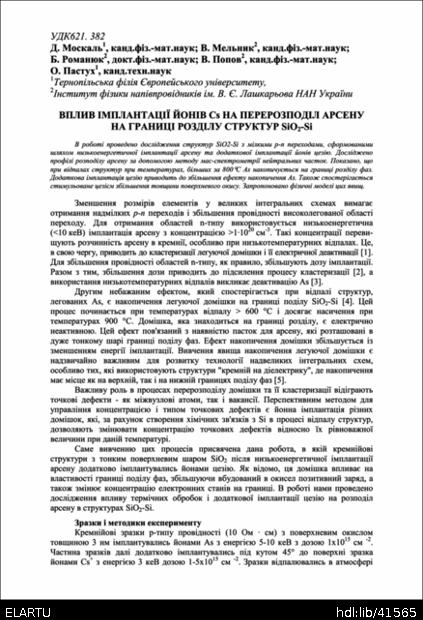Please use this identifier to cite or link to this item:
http://elartu.tntu.edu.ua/handle/lib/41565

Full metadata record
| DC Field | Value | Language |
|---|---|---|
| dc.contributor.author | Москаль, Д. | |
| dc.contributor.author | Мельник, В. | |
| dc.contributor.author | Романюк, Б. | |
| dc.contributor.author | Попов, В. | |
| dc.contributor.author | Пастух, О. | |
| dc.contributor.author | Moskal, D. | |
| dc.contributor.author | Melnik, V. | |
| dc.contributor.author | Romanuyk, B. | |
| dc.contributor.author | Pastuh, O. | |
| dc.date.accessioned | 2023-06-15T16:42:43Z | - |
| dc.date.available | 2023-06-15T16:42:43Z | - |
| dc.date.created | 2004-12-28 | |
| dc.date.issued | 2004-12-28 | |
| dc.date.submitted | 2005-03-29 | |
| dc.identifier.citation | Вплив імплантації йонів Cs на перерозподіл арсену на границі розділу структур SiO2-Si / Москаль Д., Мельник В., Романюк Б., Попов В., Пастух О. // Вісник ТДТУ. — Т. : ТДТУ, 2005. — Том 10. — № 3. — С. 181–186. — (Математичне моделювання. Математика. Фізика). | |
| dc.identifier.issn | 1727-7108 | |
| dc.identifier.uri | http://elartu.tntu.edu.ua/handle/lib/41565 | - |
| dc.description.abstract | В роботі проведено дослідження структур SiO2-Si з мілкими р-п переходами, сформованими шляхом низькоенергетичної імплантації арсену та додаткової імплантації йонів цезію. Досліджено профілі розподілу арсену за допомогою методу мас-спектрометрії нейтральних часток. Показано, що при відпалах структур при температурах, більших за 800 С As накопичується на границі розділу фаз. Додаткова імплантація цезію приводить до збільшення ефекту накопичення As. Також спостерігається стимульоване цезієм збільшення товщини поверхневого окису. Запропоновано фізичні моделі цих явищ. | |
| dc.description.abstract | The given work deals with investigation of structures SiO2-Si with shallow p-n transitions, formed by. means of low-energy implantation of arsenide and additional implantation of caesium ions. Arsenide division profiles have been discovered with help of neutral particles mass-spectrometry method. It has been showed that when the structures are being heated at temperatures over 800 degrees Celsius As is being cumulated on phase's interface. Additional caesium implantation results in increase of As accumulation effect. The increase of surface oxide thickness, stimulated by caesium is also being observed. Physical models of these phenomena have been suggested. | |
| dc.format.extent | 181-186 | |
| dc.language.iso | uk | |
| dc.publisher | ТДТУ | |
| dc.publisher | TSTU | |
| dc.relation.ispartof | Вісник Тернопільського державного технічного університету, 3 (10), 2005 | |
| dc.relation.ispartof | Scientific Journal of the Ternopil State Technical University, 3 (10), 2005 | |
| dc.title | Вплив імплантації йонів Cs на перерозподіл арсену на границі розділу структур SiO2-Si | |
| dc.title.alternative | The influence of ions Cs implantation on arsenide redistribution on the interface of SiO2-Si structures | |
| dc.type | Article | |
| dc.coverage.placename | Тернопіль | |
| dc.coverage.placename | Ternopil | |
| dc.format.pages | 6 | |
| dc.subject.udc | 621. 382 | |
| dc.relation.references | 1. М. Koh, K. Egusa, H. Furumoto et al. Quantitative evaluation of dopant loss in 5-10 keV ion implantation for low-resistive, ultrashallow source/drain formation // Jpn. J. Appl. Phys. V. 38 (1999) p. 2324-2328. | |
| dc.relation.references | 2. K. Shibahara, D. Onimatsu. Antimony clustering due to high-dose implantation // Mat. Res. Soc. Symp., v.610 (2000), p. B8.5.1. | |
| dc.relation.references | 3. J. Dabrovski, R.A. Casali, H.-J. Mussigetal. Mechanism of dopant segregation to SiO2/Si (001) interfaces // J. Vac. Sci. Technol, v. B18 (4), 2000, p. 2160. | |
| dc.relation.references | 4. Y. Sato, J. Nakata, K. Imai, E. Arai. Arsenic pileup at the SiO2/Si interface // J. Electrochem. Soc, v. 142 (2), 1995, p.655. | |
| dc.relation.references | 5. Y. Sato, K. Imai, E. Arai. Pileup of n-type dopant in SOI structure and its effect on n-well concentration // J. Electrochem. Soc, v. 142 (2), 1995, p.660. | |
| dc.relation.referencesen | 1. M. Koh, K. Egusa, H. Furumoto et al. Quantitative evaluation of dopant loss in 5-10 keV ion implantation for low-resistive, ultrashallow source/drain formation, Jpn. J. Appl. Phys. V. 38 (1999) p. 2324-2328. | |
| dc.relation.referencesen | 2. K. Shibahara, D. Onimatsu. Antimony clustering due to high-dose implantation, Mat. Res. Soc. Symp., v.610 (2000), p. B8.5.1. | |
| dc.relation.referencesen | 3. J. Dabrovski, R.A. Casali, H.-J. Mussigetal. Mechanism of dopant segregation to SiO2/Si (001) interfaces, J. Vac. Sci. Technol, v. B18 (4), 2000, p. 2160. | |
| dc.relation.referencesen | 4. Y. Sato, J. Nakata, K. Imai, E. Arai. Arsenic pileup at the SiO2/Si interface, J. Electrochem. Soc, v. 142 (2), 1995, p.655. | |
| dc.relation.referencesen | 5. Y. Sato, K. Imai, E. Arai. Pileup of n-type dopant in SOI structure and its effect on n-well concentration, J. Electrochem. Soc, v. 142 (2), 1995, p.660. | |
| dc.identifier.citationen | Moskal D., Melnik V., Romanuyk B., Pastuh O. (2005) Vplyv implantatsii yoniv Cs na pererozpodil arsenu na hranytsi rozdilu struktur SiO2-Si [The influence of ions Cs implantation on arsenide redistribution on the interface of SiO2-Si structures]. Scientific Journal of TSTU (Tern.), vol. 10, no 3, pp. 181-186 [in Ukrainian]. | |
| dc.contributor.affiliation | Тернопільська філія Європейського університету | |
| dc.contributor.affiliation | Інститут фізики напівпровідників ім. В. Є. Лашкарьова НАН України | |
| dc.citation.journalTitle | Вісник Тернопільського державного технічного університету | |
| dc.citation.volume | 10 | |
| dc.citation.issue | 3 | |
| dc.citation.spage | 181 | |
| dc.citation.epage | 186 | |
| Appears in Collections: | Вісник ТДТУ, 2005, том 10, № 3 | |
Files in This Item:
| File | Description | Size | Format | |
|---|---|---|---|---|
| TSTUSJ_2005v10n3_Moskal_D-The_influence_of_ions_Cs_181-186.pdf | 228,09 kB | Adobe PDF | View/Open | |
| TSTUSJ_2005v10n3_Moskal_D-The_influence_of_ions_Cs_181-186.djvu | 312,77 kB | DjVu | View/Open | |
| TSTUSJ_2005v10n3_Moskal_D-The_influence_of_ions_Cs_181-186__COVER.png | 515,2 kB | image/png | View/Open |
Items in DSpace are protected by copyright, with all rights reserved, unless otherwise indicated.